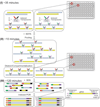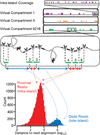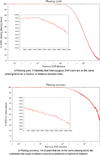Haplotype-resolved whole-genome sequencing by contiguity-preserving transposition and combinatorial indexing
- PMID: 25326703
- PMCID: PMC4409979
- DOI: 10.1038/ng.3119
Haplotype-resolved whole-genome sequencing by contiguity-preserving transposition and combinatorial indexing
Abstract
Haplotype-resolved genome sequencing enables the accurate interpretation of medically relevant genetic variation, deep inferences regarding population history and non-invasive prediction of fetal genomes. We describe an approach for genome-wide haplotyping based on contiguity-preserving transposition (CPT-seq) and combinatorial indexing. Tn5 transposition is used to modify DNA with adaptor and index sequences while preserving contiguity. After DNA dilution and compartmentalization, the transposase is removed, resolving the DNA into individually indexed libraries. The libraries in each compartment, enriched for neighboring genomic elements, are further indexed via PCR. Combinatorial 96-plex indexing at both the transposition and PCR stage enables the construction of phased synthetic reads from each of the nearly 10,000 'virtual compartments'. We demonstrate the feasibility of this method by assembling >95% of the heterozygous variants in a human genome into long, accurate haplotype blocks (N50 = 1.4-2.3 Mb). The rapid, scalable and cost-effective workflow could enable haplotype resolution to become routine in human genome sequencing.
Figures




References
Publication types
MeSH terms
Substances
Associated data
Grants and funding
LinkOut - more resources
Full Text Sources
Other Literature Sources
Miscellaneous

